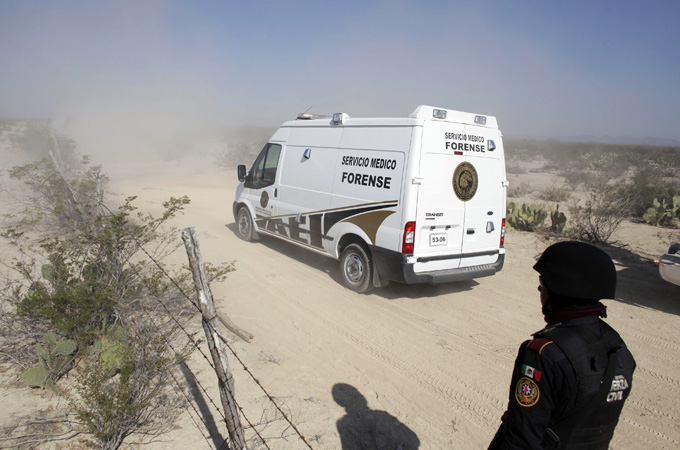
The drug war in Mexico has claimed at least 70,000 lives, but the full death toll may never be known because thousands are searching for relatives who have disappeared.
Along the border, some of those missing in Mexico are U.S. citizens.
“It’s individuals that communicated with their loved ones on a daily basis, and — all of a sudden — they disappear,” said Oscar Hagelseib, assistant special agent in charge of Homeland Security’s investigations in El Paso.
The agency helped Mexico pinpoint the location of a mass grave in the Valley of Juárez last November.
“The intelligence was there was a strong possibility there were United States citizens there,” Hagelseib said.
Just across the border from El Paso on the outskirts of Juárez, forensic workers dug up the remains of 20 men.
All had been murdered; some showed signs of torture.
A spokesman with the Chihuahua state attorney general’s office said investigators stopped digging in the area four days after they started because they had had “recovered all the remains that were at the site.”
Some of the bodies still have not been identified. Mexico continues to find mass grave sites in areas ravaged by drug violence. The U.S. State Department documents the deaths of Americans in Mexico, but does not keep a comprehensive report of U.S. citizens who disappeared.
Jason Macias disappeared on August 30, 2011. The 23-year-old worked as a school security guard in his hometown of El Paso. In his final Facebook message posted he said, “Ate a large pizza, watching a movie.”
When he failed to show up to work the next day, his family reported him missing.
Police found Macias’ passport and cell phone in his apartment. His truck was parked outside. Detectives investigating the case suspect foul play.
A bulletin was issued after his disappearance, and noted Macias had traveled to Chihuahua, Mexico on several occasions a couple of months before he vanished.
His mother said that was unusual.
Macias’ family lives on the U.S. side of the border, but his mother was afraid to talk about the details of the disappearance. Others are banding together to speak out.
On a recent evening a few blocks from the border, a vigil was held.
“Tonight, Annunciation House bears witness to the disappeared by projecting over 9,000 of the names from all over Mexico of the desaparecidos [missing],” said Ruben Garcia, director of Annunciation House.
The non-profit organization helps migrants and refugees. In recent years, it has seen a spike in the number of Mexicans fleeing violence.
At the vigil, the names of people missing in Mexico were projected on the side of a building as volunteers, family members and others lit candles to remember the disappeared.
“I really didn’t know much about the disappeared until I moved to the border,” said Kristen Bowdre of Dallas, who is spending a year volunteering at Annunciation House.
The parents of two young women who disappeared spoke to the crowd.
Diana Ramirez Hernandez and Monica Alanis Esparza were both 18-year-old college students when they vanished.
“They’re not dead, but we’re not living either,” said Ricardo Alanis Esparza. His daughter, Monica, has been missing since 2009. Agent Hagelseib understands their pain.
“Personally, it happened to me where a cousin was killed by a drug cartel and he had nothing to do and was never involved in this.” Hagelseib said. “He was just in the wrong place at the wrong time. They wanted his truck, so they killed him.” Many other families continue to search for answers.
Mexico’s Interior Ministry estimates 26,000 people were reported missing during the six years when Felipe Calderón was president and drug violence spiked. The current administration released that number, but did not say which cases may be tied to organized crime.
Human Rights Watch released a report in February that said it documented at least 250 cases of people who disappeared. Human rights organizations say military and police are behind some disappearances.
Whatever the circumstances, in many cases, families are left to search for their missing loved ones on their own.
Victim’s advocates are now calling on the Mexican government to create a national DNA database to help match the missing with bodies waiting to be indentified in morgues. Relatives in many states have provided authorities with DNA samples.
Monday 6 May 2013
http://www.wfaa.com/news/texas-news/206206041.html

0 comments:
Post a Comment